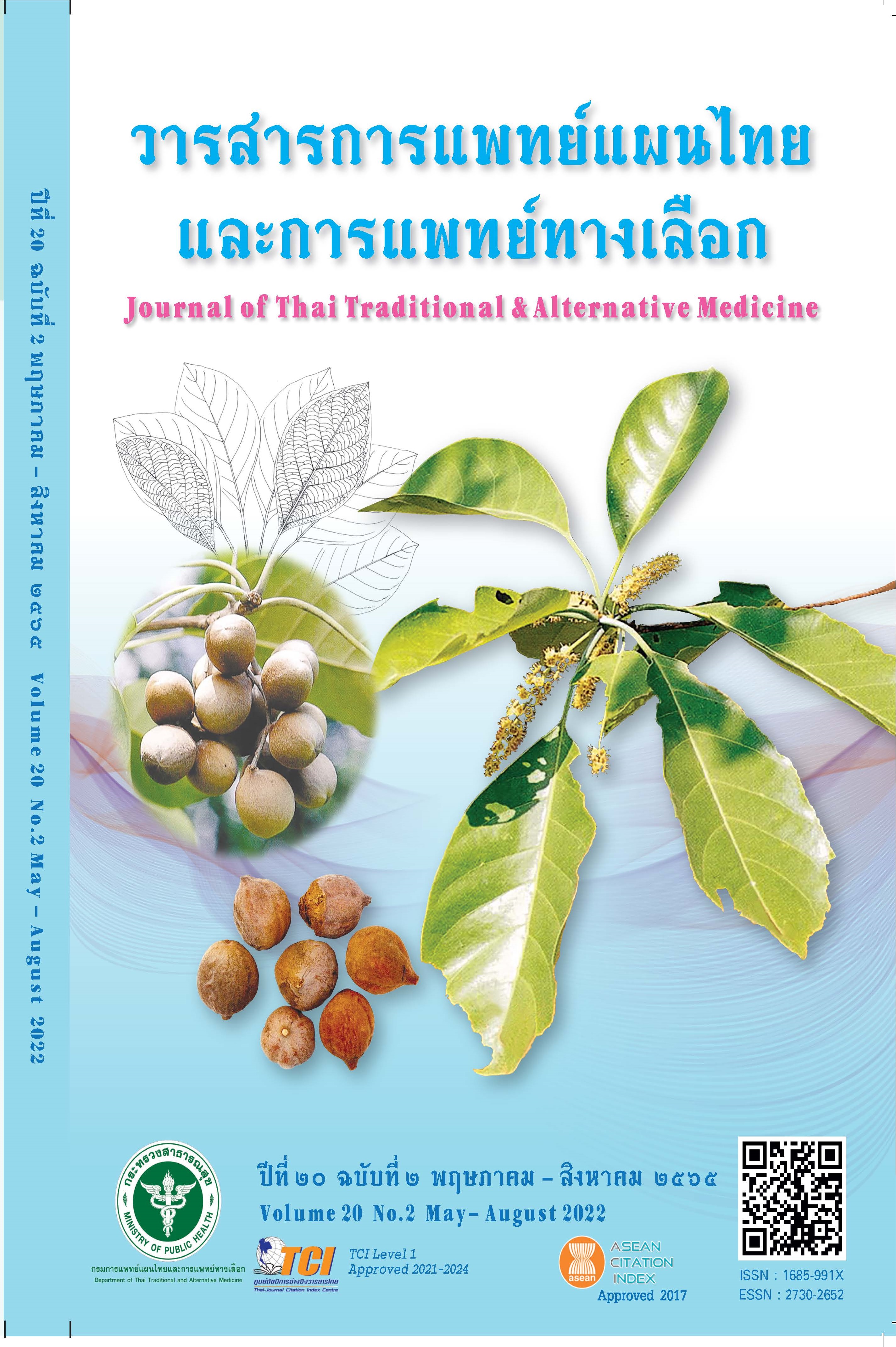The Effects of Using the Thai Ways Program to Stimulate Lactation on the Amount and Duration of Milk Flow in Postpartum Mothers
Main Article Content
Abstract
This quasi-experimental research aimed to compare the effects of using the Thai Ways program to stimulate lactation on the amounts and durations of milk flow in postpartum mothers. Study participants were 130 first-time mothers at 4 hours after normal delivery with normal vital signs; and they were purposively selected from those 21–35 years of age and randomly divided into five groups: 1) control group, 2) experimental group that drank boiled ginger drinks, 3) experimental group that received breast massage, 4) experimental group that received breast herbal compression, and 5) experimental group that received all treatments. Each of the experimental groups received one treatment that lasted 15 minutes, and their milk volumes were measured every hour after the experiment until 4 hours had passed. Data collection instruments were a questionnaire and a milk-volume record form. Milk quantity data were collected and analyzed using percentage, mean, standard deviation, paired t-tests, and one-way ANOVA statistics. The results showed that, when comparing the differences in the volumes of maternal postpartum milk flow in the 2nd to 5th treatment groups from pre-program until the end of the 4-hour study period, the mean milk volumes were 0.63 ± 0.18, 2.01 ± 0.26, 2.94 ± 0.22, 4.54 ± 0.97 mL, respectively, and were significantly different from that in the control group (p < 0.05), which had a mean milk volume of 0.16 ± 0.09 mL. Therefore, it can be concluded that the application of the Thai Ways program to increase breast-milk flow at 4 hours after delivery could boost the amount of milk flow more rapidly from the first hour of the program with an average increase of 2.15 mL per hour. Thus, this program will be an alternative for promoting breastfeeding in health-care facilities.
Article Details

This work is licensed under a Creative Commons Attribution-NonCommercial-NoDerivatives 4.0 International License.
References
Ip S, Chung M, Raman G, Chew P, Magula N, DeVine D, Trikalinos T, Lau J. Breastfeeding and maternal and infant health outcomes in developed countries. Evid Rep Technol Assess. 2007;153:181-6.
Horta BL, Bahl R, Martinés JC, Victora CG, World Health Organization. Evidence on the long-term effects of breastfeeding: systematic review and meta-analyses. Geneva: World Health Organization; 2007.
Breastfeeding and the use of human milk. Pediatrics. 2012;129(3):e827-41.
doi: 10.1542/peds.2011-3552.
Breastfeeding Center of Thailand. Breastfeeding specialist training manual. Bangkok: Office of Health Promotion, Department of Health, Ministry of Public Health; 2007. (in Thai)
Holdcroft A, Snidvongs S, Cason A, Dore CJ, Berkley KJ. Pain and uterine contractions during breast feeding in the immediate post-partum period increase with parity. Pain. 2003;104(3):589–96.
Binns C, Lee M, Low WY. The long-term public health benefits of breastfeeding. Asia Pacific Journal of Public Health. 2016;28(1):7-14.
Stuebe AM, Schwarz EB, Grewen K, Rich-Edwards JW, Michels KB, Foster EM, Curhan G, Forman J. Duration of lactation and incidence of maternal hypertension: a longitudinal cohort study. American of Journal Epidemiology. 2011;174(10):1147-58.
Von der Ohe G. Benefits of Breastfeeding. Dtsch Arztebl Int. 2018;115(26):453.
Chiangta P, Baotuang C, Kantharaksa K. Effects of social support on the success of exclusive breastfeeding among early mothers. Nurse Practitioner. 2014;41(3):1-12. (in Thai)
Yimyam S. Breastfeeding promotion among outside employed mothers. Nursing Journal. 2013;40(3):129-37. (in Thai)
Kaewnaluang S, Jompapin N, Bankhum S, Pongpirul K, Natakankitkul S, Kanchanarat P. Safety and benefits of Pluk Fai That recipe in breastfeeding mothers. Journal of Thai Traditional & Alternative Medicine. 2021;19(2):354-
(in Thai)
Riordan J, Wambach K. Breastfeeding and human lactation. Sudbury, Mass.: Jones and Bartlett Publishers; 2010; Available from: http://site.ebrary.com/id/10530161
Phakdeechot S, Morarad R, Sakontarat P. The effect of increasing milk production program on secretion time of colostrum in postpartum mothers, Sakon Nakhon Hospital. Journal of Public Science. 2010;19(2):279-87. (in Thai)
Trainapakul C, Chaiyawattana M, Kanavitoon W, Tiumtaogerd R, Naka S, Mitrniyodom W, et al. Effect of milk ejection performance of postpartum mothers after breasts massage and compression with mini hot bag
and herbal compress. Journal of Nursing and Education. 2010;3(3):75-91. (in Thai)
Anukoolprasert P. Comparison between breast massage alone and breast massage combined with a warm compress in increasing milk production in post-partum mothers. Journal of Health Systems Research. 2007;1(3-4):430-38. (in Thai)
Meepradit K. Effects of postpartum herbal of Kab Choeng Hospital, Surin Province (thesis). Master of Science, Pharmaceutical sciences. Bangkok: Silpakorn University; 2011. 130 p. (in Thai)
Wongsirisuwaphan A. Breast massage: The way to increase milk. In: Kanchana S, editor. The 4th National Breastfeeding Conference; 2013 June 5-7; Miracle Grand Convention Hotel. Bangkok: Thaibreastfeeding center;
p. 1-164. (in Thai)
Thai Traditional Medicine Institute. Health care for women giving birth using Thai traditional medicine. 2nd. Bangkok: Business Publishing House The Veterans’Welfare Organization Printing House, Thai Traditional
Medicine Institute Division of Healing Arts; 2008. (in Thai)
Srisuwaphan A. Effect of ginger drink on the starting of lactation period in postpartum women. Medical Journal of Srisaket Surin Buriram Hospital. 2013;27(3):243-50. (in Thai)
Smith J, Riordan J. Postpatum care. In: Riordan J, Wambach K, editors. Breastfeeding and human lactation. 4th ed. Massachusetts: Jones and Bartlett; 2010. P. 79-112.
Charoensungdej K, Anuchitchanchai J, Caroti N, Sunthorn Athorn. The effectiveness of breast massage and hot compression with herbs to stimulate breast milk ejection in first 72 hours. Uttaradit Hospital Medical
Journal. 2013;28(3):24-36. (in Thai)


